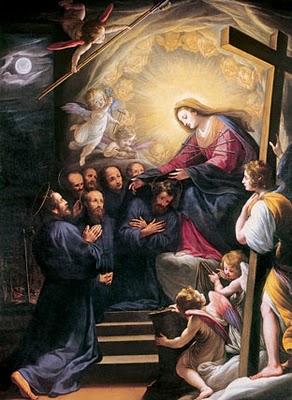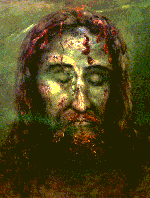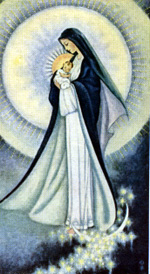
|
OUR LADY OF FATIMA CRUSADER BULLETIN |
Vol. 40, Issue No. 101 |
| Prayer to the Holy Face of Jesus | |
The Seven Holy Founders of the Servants of Mary

In the Year of Our Lord 1233, there lived in the thriving city-republic of Florence seven wealthy, distinguished young businessmen. The youngest of this group of close friends was twenty-seven, and the eldest thirty-five. One was a handsome banker. Another was a scholar. Another was interested in the turbulent politics of the times. Two were married, and one was a widower. All seven were unusually good Catholics. Five years previously they had joined the Confraternity of the Laudesi (Praisers) of Our Lady, and they loved to attend together the regular meetings, at which they prayed and sang hymns in honor of the Blessed Virgin Mary.
Then, all of a sudden, on the Feast of Mary's Assumption, after having received Holy Communion, while they were meditating and making their thanksgiving after Mass, each of these fine young men simultaneously had an unforgettable mystical experience which drastically changed the whole course of his life: each one separately saw a supernaturally bright light, and in it appeared the beautiful Queen of Heaven, accompanied by many Angels. And Mary said to each of them: "Leave the world and retire together into solitude in order to fight yourselves. Live wholly for God. You will thus experience heavenly consolations. My protection and assistance will never fail you."
The lovely vision slowly vanished, leaving seven deeply moved young men in the now-deserted church. They looked at one another in stupefied silence, each wondering whether the other had had the same vision, and not knowing whether to reveal what he had experienced. Finally Bonfilius Monaldi, the eldest, took the initiative and humbly told his friends what he had seen and heard. Then the six others excitedly declared they had had exactly the same vision. And soon all seven knelt before the altar, and with violently beating hearts, resolved to obey this overwhelming Divine call.
They went at once to consult the worthy spiritual director of Our Lady's Confraternity, Father James of Poggibonsi. Both he and the Bishop of Florence were so impressed by the young men's sincerity and piety that they approved their decision as fulfilling the Will of God. Therefore, during the next three weeks, the seven wealthy businessmen broke the astounding news to their families and friends, who were also inspired by God to acquiesce and cooperate in this extraordinary vocation. It is believed that the two wives entered a Religious Order. The seven young men sold all their personal property and gave the money to the poor.
At last, on the Feast of the Nativity of the Blessed Virgin Mary, they bade farewell to all their dear ones, exchanged their rich senatorial robes for coarse gray monk's habits, and with the Bishop's blessing, they left their comfortable homes and went to live in a dilapidated old farmhouse on the outskirts of the town. While Father James served as their chaplain, they elected Monaldi their superior. However, they had no intention of founding a new religious order. All they wanted was to live an obscure life of extreme mortification and penance and thereby to purify themselves, out of love for God, as His Mother had advised. They spent their time almost entirely in prayer, meditation, and penitential exercises, striving in every way to devote themselves completely to Jesus Christ through Mary, in whose honor they reserved every Saturday.
In order to practice humility in one of its most humiliating forms, they asked the Bishop for permission to beg their food from door-to-door among the countless fellow citizens who had known them as prosperous merchants. The Bishop granted them this permission. And as the seven holy friends were passing through the streets, a crowd gathered to watch them. Some considered them cranks, while others felt they were saints. But in this moment a number of babes-in-arms who had never spoken before suddenly cried out: "Look at the Servants of Mary!"
The same thing happened several times later when two of the young men were begging for food. In fact, one five-month-old baby who told his astonished mother to give alms to "the Servants of Mary" grew up to be St. Philip Benizi, one of the most famous Generals of the Order.
But as a result of such sensational events, crowds of visitors began to disturb the holy men's solitude. Therefore they decided to move to some isolated spot far from the city. Not knowing where to go, as usual, they turned to Mary for guidance. And in May, 1234, the Blessed Virgin showed them in a vision a lonely tree-covered mountain and said: "Go to Monte Senario, and live still more austerely!"
When they consulted the Bishop, they were amazed to learn that this property belonged to the Diocese, and he gladly gave them part of it.
Consequently, early on a beautiful Spring morning, after receiving Holy Communion, the seven Servants of Mary joyfully set out in a procession, carrying a large Cross and the statue of the Blessed Virgin which had stood in their oratory. As it was the Vigil of the Ascension, they were fasting. They chanted hymns in honor of their Queen as they marched more than ten miles northward through the lovely Tuscan countryside. Soon they caught sight of the mountain of their vision rising above several other hills to an altitude of 2,700 feet. Making their way with the greatest difficulty along an abandoned path overgrown with bushes and brambles, they struggled up through a thick forest of tall pine trees, until at last they came to the mountaintop where, to their great joy, they found a beautiful sunlit clearing protected from the wind by the surrounding forest. An opening between the trees provided a marvelous view. It was here that they fixed their Cross and knelt to thank Our Lady for guiding them to such an ideal retreat. Then they discovered a spring of sparkling fresh water. And as they filled their lungs with the crisp, cool mountain air, they understood why this height had been named Monte Senario, for "Senario" means "healthy air." Next, they set about building a small chapel in the ruins of an old castle, and nearby they put up seven tiny shelters made of boughs, though they had to spend their first nights in caves.
During the following years they led such a strict and mortified life on this mountaintop that, once, when a Cardinal visited them, he was so shocked by their austerity that he ordered them to be less cruel to themselves. Having observed that some of the seven hermits kept complete silence for long periods, while others persisted in dwelling in caves and tried to live on nothing but herbs, he strongly advised them to adopt one set rule of community life for all.
At the same time they were confronted with another problem: many young men were seeking them out and begging to be admitted into their company. But the seven rejected all such requests, because they still humbly refused to consider themselves a new Religious Order. So again they turned to the Blessed Virgin Mary for guidance, and consulted their Bishop.
In answer to their fervent prayers, they were given a sign. On the Third Sunday in Lent, February 27,1239, to their utter amazement they found that a vine which they had planted had miraculously developed green leaves and clusters of ripe fruit, while all around, the other plants remained bare and frostbitten! When this marvel was told to the Bishop, he declared that it had been thus interpreted to him in a dream: the seven branches of the vine represented the seven hermits; the grapes were those who were going to join the Order, for as true religious they were henceforth to spread devotion to Our Lord Jesus Christ and His Sorrowful Mother among the people.
Accepting this plan as the Will of God, the seven holy men decided to reorganize their group on the coming Feast of Easter. Meanwhile they went back to their mountain retreat and prayed more fervently than ever for Divine assistance in their new vocation, and they debated among themselves which Religious rule and what sort of habit to adopt.
During Holy Week they redoubled their prayers, fasting, and mortification. Finally, on the evening of Good Friday, April 13,1239, which that year happened to coincide with the Feast of the Annunciation, while the seven exhausted hermits were saying their night prayers, the Blessed Virgin again appeared to her faithful Servants, surrounded by Angels, bearing a habit, a book, a scroll and palms. As the holy men gazed at their Heavenly Patroness with rapt devotion, Mary said to them: "Beloved and elect Servants, I have come to grant your prayers. Here is the habit which I wish you to wear henceforth. It is black that it may always remind you of the keen sorrows which I experienced through my Son's Crucifixion and Death. This scroll bearing the words 'Servants of Mary' indicates the name by which you are to be known. This book contains the Rule of St. Augustine. By following it you will gain these palms in Heaven, if you serve me faithfully on earth!"
Thus did Mary herself found the new Order of her Servants. She also gave the same message to the Bishop, who gladly erected the group into an Order at a beautiful ceremony in their hermitage on Monte Senario. Of the Seven Founders, six now prepared themselves for the Priesthood. But one, St. Alexis Falconieri, though he had been a brilliant student, insisted on remaining a simple Brother and servant of the others. Many years later this humble man had the great joy of seeing one of his nieces, Juliana, become a saintly Servite nun.
The new Order of Servants of Mary, or Servite Fathers, expanded marvelously, as the Blessed Virgin inspired many fine young men to join it. Within a few years it numbered over one hundred houses. The Blessed Virgin Mary herself appeared separately to Philip Benizi and Peregrine Laziosi and told them to enlist among her Servants, and both became Servite saints. When the Pope sent St. Peter of Verona to inspect the Order and report as to whether it should be approved or dissolved by the Holy See, Mary appeared to the Saint and told him how dear her Servants were to her.
The Seven Holy Founders, after many years of hard work in her service, were rewarded with particularly beautiful deaths. One passed away while at prayer before the altar, meditating on the sufferings of Our Lord. The first leader and General, St. Bonfilius Monaldi, was in the chapel one morning when he heard Mary's sweet voice say to him: "Good Son, thou hast faithfully listened to and followed the voice of my Son. Come now to receive a hundred times what thou hast given and to possess eternal life!" When another died, a great flame was seen shooting up from his couch toward Heaven. Two more, as tired old men, painfully climbed to their beloved Monte Senario for the last time after long and arduous missionary trips, and passed away at the same moment.
The last to leave this world was the humble Brother, St. Alexis. One day when he was over a hundred years old, knowing his end was near, he paid his last tribute to his Mother in Heaven by reciting a hundred Aves. As he finished, he saw the Child Jesus approach and affectionately crown him with lovely flowers. Then Alexis cried out: "Kneel, my Brethren, do you not see our loving Lord? He will also crown you if, through true devotion to the Blessed Virgin, you imitate her Immaculate purity and her profound humility." And thus he went to his reward.
Down through the centuries, the Order founded by these seven loyal Servants of Mary, whom Pope Leo XIII canonized in 1888, has faithfully spread devotion to the Sorrowful Mother. It was they who gave the Church the beautiful Feast of the Seven Sorrows of the Blessed Virgin Mary. And most significantly, it is Mary's Servants, the Servite Fathers, who during recent years of worldwide suffering (before Vatican II) have been largely responsible for the tremendous, almost miraculous increase in popularity of the Sorrowful Mother Novena.
(based on an account by Raphael Brown)
 Prayer In Honor of the Holy Face of Jesus
Prayer In Honor of the Holy Face of Jesus
May the most holy, most sacred, most adorable, most incomprehensible and ineffable Name of God be forever praised, blessed, loved, adored and glorified, in Heaven, on earth, and under the earth, by all the creatures of God, and through the Sacred Heart of Our Lord Jesus Christ in the Most Holy Sacrament of the Altar. Amen.
O Divine Jesus, through Thy Holy Face and Name, save us. Our hope is in the virtue of Thy Holy Name!
Be merciful to us, O my God, and reject not our prayers, when amid our afflictions, we call upon Thy Holy Name and seek with love and confidence Thine adorable Face. Amen
Divine Countenance of Jesus, shine down upon us!

O Purest of Creatures
O Purest of Creatures, Sweet Mother Sweet Maid;
The one spotless womb wherein Jesus was laid.
Dark night hath come down on us, Mother, and we
Look out for thy shining, Sweet Star of the Sea. (repeat)
Deep night hath come down on this rough-spoken world,
And the banners of darkness are boldly unfurled;
And the tempest-tossed Church--all her eyes are on thee;
They look to thy shining, Sweet Star of the Sea. (repeat)
Visit also: www.marienfried.com
